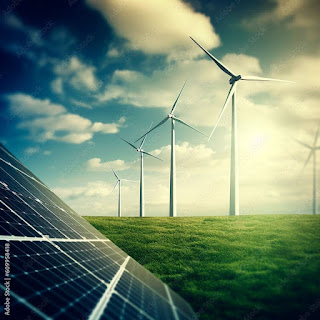The Future of Renewable Energy: Innovations Shaping the Green Revolution
Introduction: Renewable energy is rapidly emerging as the cornerstone of a sustainable future. As we face the growing challenges of climate change, energy consumption, and environmental degradation, the shift to cleaner, greener energy sources is no longer a luxury—it is a necessity. In this blog, we explore the innovations in renewable energy that are shaping the future of the green revolution and how these advancements are making it possible for the world to transition from fossil fuels to renewable sources of power.
1. Solar Energy: The Power of the Sun Solar energy has seen incredible advancements over the past decade, making it one of the most viable and accessible renewable energy sources. The development of more efficient photovoltaic (PV) cells, along with the declining costs of solar panel installations, has opened up new opportunities for solar power to be used in both residential and commercial applications. The future of solar energy includes:
Perovskite Solar Cells: Perovskite solar cells are an emerging technology that promises to be more efficient and cheaper than traditional silicon-based solar cells. Their potential to revolutionize the solar industry is enormous.
Solar Panels on Buildings and Infrastructure: Integrating solar panels into the fabric of buildings—such as rooftops, windows, and facades—can turn entire cities into power-generating hubs.
2. Wind Power: Harnessing the Power of the Breeze Wind energy has long been a staple of renewable power generation, but advancements in turbine design are allowing wind farms to generate more energy with fewer resources. Offshore wind farms are also becoming more prevalent, offering the potential to harness stronger, more consistent winds far from land. Innovations in wind energy include:
Floating Wind Turbines: These turbines can be placed in deeper waters where traditional turbines cannot be installed. This technology expands the potential for offshore wind power.
Larger Turbines: Newer, more powerful turbines are capable of generating more energy with each rotation, improving the efficiency of wind farms.
3. Energy Storage: Solving the Intermittency Problem One of the challenges of renewable energy sources like solar and wind is their intermittency—meaning they don't generate power continuously. The sun doesn’t always shine, and the wind doesn’t always blow. Innovations in energy storage are crucial for overcoming this challenge. The future of energy storage includes:
Solid-State Batteries: These batteries offer higher energy density and are safer and more durable than current lithium-ion batteries, making them a game-changer for large-scale energy storage.
Pumped Hydro Storage: This involves using excess electricity to pump water uphill, where it can be stored and released to generate electricity when needed.
4. Geothermal Energy: Tapping into the Earth’s Heat Geothermal energy is another renewable resource that is gaining attention. By tapping into the Earth’s internal heat, geothermal power plants can produce continuous, reliable energy. Innovations in geothermal energy include:
Enhanced Geothermal Systems (EGS): EGS allows for the extraction of heat from areas that were previously not viable for geothermal energy production, expanding the potential for this energy source.
5. Hydrogen Energy: A Clean Fuel for the Future Hydrogen is emerging as a promising clean fuel source, particularly for sectors that are difficult to electrify, such as transportation and heavy industry. Green hydrogen, produced through the electrolysis of water using renewable electricity, has the potential to revolutionize the energy landscape. The development of hydrogen fuel cells for vehicles and industrial applications is a key area of focus.
Conclusion: A Greener Tomorrow The future of renewable energy is bright. Innovations in solar, wind, energy storage, geothermal, and hydrogen energy are creating a more sustainable energy future. However, there is still much work to be done to scale these technologies and integrate them into our global energy infrastructure. By continuing to invest in research, development, and policy support, we can accelerate the transition to a cleaner, greener energy system that benefits both the planet and future generations.

